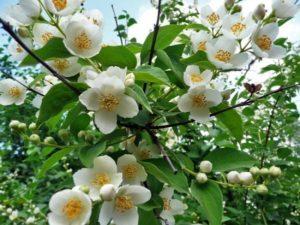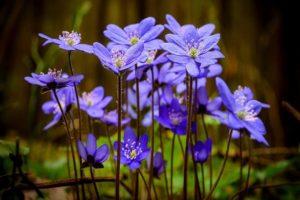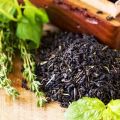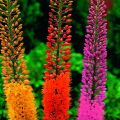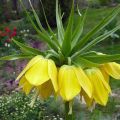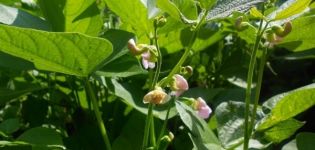15 best shade-loving plants for the garden blooming all summer
There are always places in the garden that are in the shade most of the day. But even the most shady garden can be decorated with many different plants that will fully develop and delight their owner. Shade-loving plants do not always bloom spectacularly in the garden, but they have beautiful foliage.
Popular shade-loving bushes
Experts advise to purchase plant seedlings only in specialized and proven stores.
Hosta
Hosta is an ornamental deciduous perennial plant. Hosta bushes are brightly colored. They can be blue, green, gray with a contrasting border or stripes of a lighter color.
Bushes are planted in partial shade, in places protected from the wind. The bushes cover a large area of land around them with their foliage. Thus, they suppress the growth of weeds and almost do not need to loosen the soil. The hosta is a disease resistant shrub, but it is susceptible to frequent attacks by slugs and snails.
You can plant the host not only in open ground, but also in wide pots, decorating them with uncomfortable corners of the garden.
Astilba
A perennial plant in which the ground part dies off for the winter. Feels comfortable in the shade and tolerates high soil moisture. There are about 400 species. Their size varies from 15 to 400 cm.
The plant begins to bloom in July, flowering lasts 25-35 days. Flowers are collected in panicle inflorescences 10-60 cm high. The colors are also different, but white, pink, purple and red astilbe look the most attractive.
Prolonged drought, poor soil, open and hot sun can destroy the plant. In dry weather, it is watered twice a day, in the morning and in the evening.

Astilboides
The homeland of the plant is China. There, astilboides grows in ravines and forests. Plant height is about 30 cm, while the diameter of the leaves is 70 cm, which grow on long petioles. The peduncle grows 1.5 m tall. The flowers on it are small, collected in inflorescences, similar to panicles.
The bush is moisture-loving, and if the soil is sufficiently moist, then it tolerates bright sunlight, but it is still better to plant it in partial shade. It tolerates frost well without shelter. Astilboides are fed 2-3 times a season with organic fertilizers. Does not need a transplant for years. Old foliage is clipped.
Buzulnik
An unusual and beautiful plant of the Asteraceae family, which will decorate any summer cottage or garden. Buzulnik blooms with bright yellow-orange inflorescences that attract attention.

The shrub is hardy to weather conditions, does not need mulch for the winter period. It has been growing for decades in one place, without needing a transplant. It can grow on any soil, even if it is heavy and clayey. Still, he prefers moist and fertile soil in the shade. In direct sunlight, the bush will fade and look unpresentable.
The buzulnik has strong and resilient branches, but during flowering it needs a garter. You also need to tie up the plant if it grows in a windy area.
Brunner (Forget-me-not)
Although this perennial shrub blooms, its beauty lies in its foliage. It appears throughout the season, which gives the shrub freshness and elegance. Prefers semi-shady or sunny places with moist fertile soil.
Brunner is a hardy bush. In order for it to be lush, for the winter they mulch the soil with compost, humus-filler or peat. In spring, fertilizing is carried out with mineral fertilizers. The plant is extremely rare.
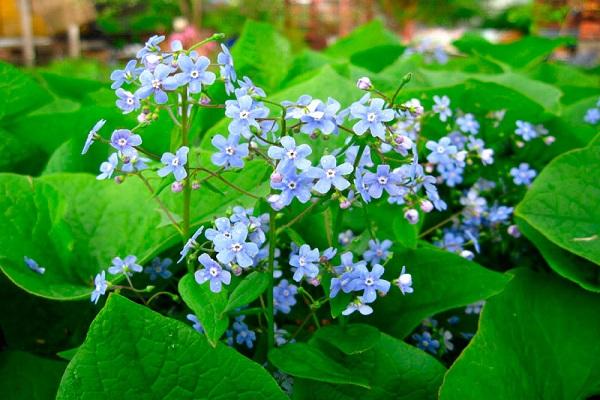
Badan
Badan is also a perennial plant that can grow for a long time without transplanting. In the next 10 years after disembarkation, it will definitely not have to be replanted. The bush has a thick rhizome close to the surface. It has large shiny rounded leaves.
The shrub blooms in lilac, bright pink or white, creating a beautiful contrast to the green foliage. This happens in late spring and lasts 20 days. Badan fits perfectly into the design of rocky gardens.
Volzhanka
The shrub has spreading bushes with an abundance of white inflorescences. Flowering period from June to late July. Its height is about 2 m. Volzhanka grows calmly both in the sun and in the shade. But growing under the open sun, Volzhanka shrubs develop poorly. The best soil for planting will be wet soil with drainage.
The plant is unpretentious in care. It can grow in one place for 15-20 years. Although it is resistant to cold weather, gardeners insulate it for the winter. Propagated by dividing the bush, cuttings and through the seed.
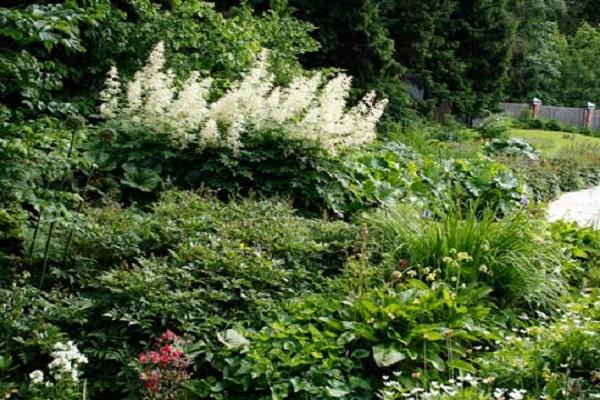
Geichera
The main advantage of this herbaceous plant is its bright and varied foliage palette. Its leaves are colored in the most unpredictable colors, such as gray, white or cream, purple, brown or red.
Most of the Heuchera varieties have a presentable appearance, starting in early spring and ending in late autumn. The first snow that falls often covers the plant along with the foliage. Gardeners love Heuchera not only for its beauty, but also for its unpretentious care and shade tolerance. If the bush grows in good soil, then it does not need feeding, it is resistant to pests and diseases.

Dicentra (Broken Heart)
A perennial plant with a height of 30 to 100 cm. Its leaves are green with a bluish tinge, the shape is pinnately dissected. The flowers are heart-shaped, reddish or pink, drooping, about 2 cm in diameter. They are collected on an arched branch, which is raised above the bush.
The planting site is prepared in the fall, digging up and fertilizing the site with humus. During the season, they feed 2-3 times, remove weeds and loosen the soil. In droughts, additional watering is required.
If you cut off the faded brushes from the bush, then the flowering period increases.
Black Cohosh (Tsimitsifuga)
This herbaceous shrub is named for its insecticidal properties. Another name for the shrub is Silver Candles, it most fully describes the beauty of the plant.
Height is 1-2 m. In dwarf varieties 60 cm. Pinnately-divided foliage of burgundy or green color. The bush blooms with long thin candle inflorescences 20 cm high. The inflorescence consists of tiny white flowers with stamens, this creates the effect of lace and translucency.
Often used in modern trends in landscape design.
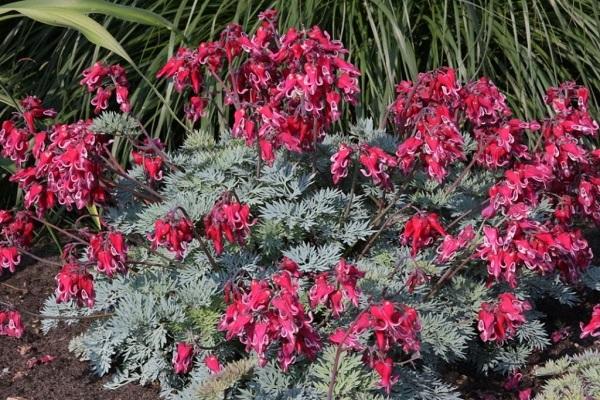
Kupena
The Kupena genus consists of more than 50 species.Most often in nature, they are found in the lowland forests and mountains of the Northern Hemisphere. The plant has a curved stem with bright green leaves arranged in two rows. Flowers hang from the axils of the leaves.
Outwardly, the kupena is similar to a lily of the valley, but this is not surprising, because they are from the same family of Liliaceae. Therefore, the kupena is sometimes called a deaf lily of the valley. These cute bushes have medicinal properties. They are used to treat cardiovascular diseases and back pain.
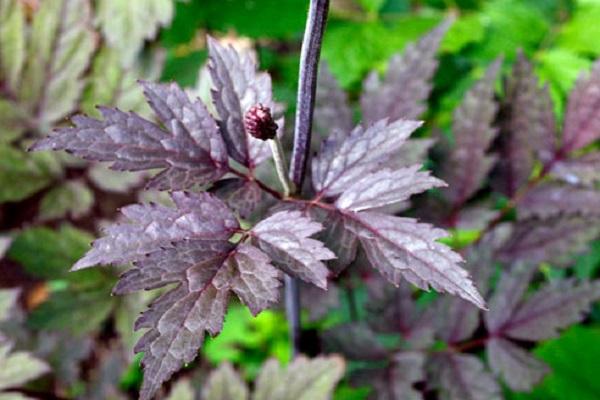
Fern
Ferns are found in almost every climate, from coniferous forests to the tropics. Due to the structure of their branches, which are called vayami, ferns look quite graceful.
This eye-catching plant also attracted our ancestors, who saw in it something magical and enchanting. Many myths and legends have been told about ferns. But today, gardeners use it as an ornamental plant in their flower beds and gardens.
When planting a fern on a site, the main thing is to choose the right place for it, darkened and humid.
Rogersia
Rogersia is a large perennial, belongs to decorative deciduous plants. There are 8 species in the genus, native to Japan and China.
It blooms with white paniculate inflorescences, reaching 120 cm during this period. The leaves are palmate-lobed. Taking care of this perennial, you need not only to water and feed it, but also to clean the curtain of leaves and stems that have died out.
Having planted Roderzia on his garden plot, the owner will immediately notice her dominance in the flower garden.
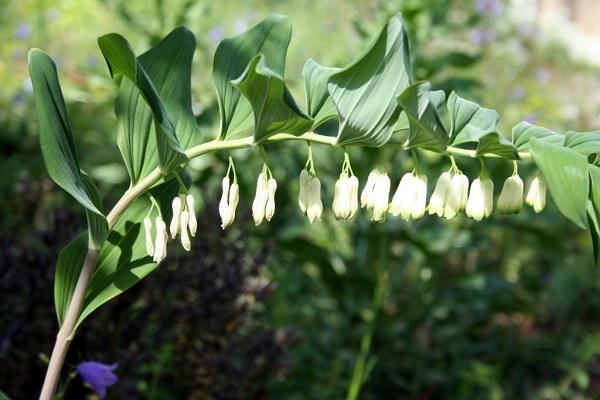
Aquilegia
It is a beautiful flower with a diameter of about 3-8 cm, usually two- or three-colored. The most common colors are white, yellow, pink, blue, blue and purple. Flowering period May-July.
Reproduction takes place by scattering seeds, and already the seedlings dive and transplant to a permanent place. They are not propagated by division, since adult plants do not tolerate transplants well.
The flower is planted both in the shady corners of the site and under the sun. Aquilegia tolerates any soil well, but thrives better on loose sandy soils with sufficient moisture.
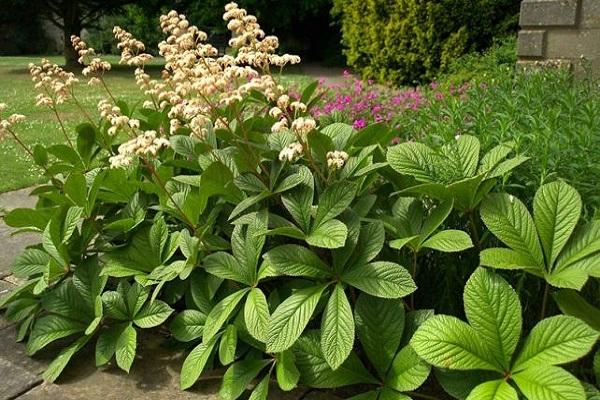
Garden geranium
These flowers bloom beautifully, forming picturesque thickets. Their leaves retain their decorative appearance from early spring to the first snow in autumn. Winter is easily tolerated, without any preparation. Growing rapidly.
The flowers of the bush are large, about 4-5 cm in diameter. The leaves are deeply dissected. In spring and summer they are green, and in autumn they are red or red-orange.
Geranium is drought-resistant. It grows in any soil, but prefers a well-drained, moist, water-free soil.
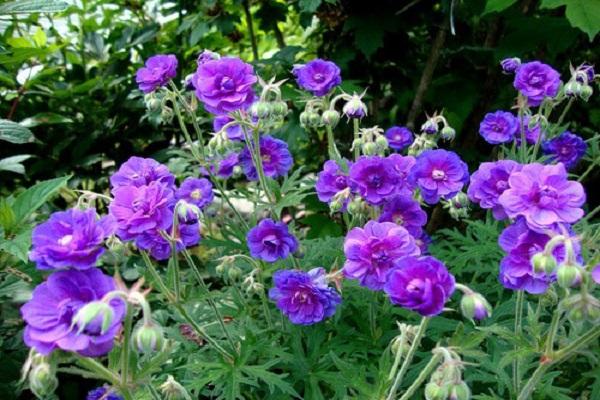
Hydrangea
Gardeners love the perennial shade-tolerant hydrangea flowers for its beautiful and long flowering, which begins in spring, lasts all summer and ends in late autumn. The garden in which the hydrangea blooms will not be inconspicuous, since the color range of the plant's inflorescences is varied, ranging from cream to blue and red.
Shrub hydrangea varieties grow up to 1-3 meters in height. Liana-like varieties reach 30 meters. Also, the plant can be evergreen or deciduous.
Interesting to know! The color of a large-leaved hydrangea depends not only on its variety. It changes depending on the pH of the soil and the amount of aluminum in it.

Features of growing and care
To achieve lush greenery and bright flowering in a shady flower garden, you need to properly care for the plants.
Most of the shade-loving species require abundant moisture. They especially need watering in late spring, when hot weather begins. Plants are watered without waiting for them to wither.
All plants, except for wild ones, also need periodic fertilizing. It is also important to loosen the soil, because then the inhabitants of the shady garden will be able to more easily absorb moisture from the soil.
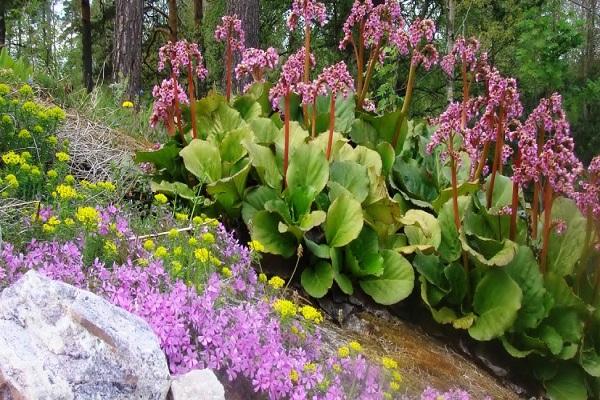
Rules for creating a beautiful flower bed from shade-loving plants
A variety of flower beds are collected from shade-loving plants. Multilevel plantings and island flower beds are popular. When planting shrubs and flowers, they adhere to the scheme. Plant no more than 10 ground cover bushes, 5 medium-sized, 7 low-growing and 3 tall plants on 1 square meter. Then the flower bed will not only look harmonious, but also the shrubs will feel good.
Shade-loving plants are in demand among gardeners. This is because they are perennial and will delight the owners with bright colors for more than one year with minimal and uncomplicated care.
